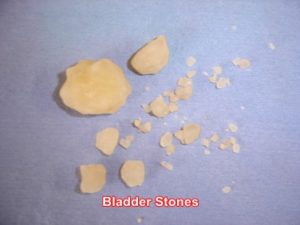Urinary Tract Disorders
CLICK ON A TOPIC BELOW TO LEARN MORE
Acute Renal Disease
Acute renal disease is a general term referring to kidney disease of sudden onset. About three- fourths of kidney tissue must be damaged before signs of illness appear. Kidney disease is often life-threatening, as the body cannot eliminate waste products and/or maintain the balance of fluid and electrolytes. Causes of acute renal disease include metabolic disorders, neoplasia, infections, diseases of the immune system, toxins, trauma and urinary tract obstructions. Damage to the kidneys may not be reversible in all cases. Signs may include anorexia, lethargy, depression, vomiting, diarrhea, increased water consumption and increased or decreased urine output. Diagnosis is afforded via history, physical exam, complete blood count, blood chemistries, urinalysis, urine culture, serology (eg. Leptospirosis, Rocky Mountain spotted fever, Erlichiosis), radiography, ultrasonography and renal biopsy. Treatment may include fluid therapy, diuretics, dopamine, antiemetics, phosphate binders, acid blockers, electrolyte balance and supportive care.
Chronic Renal Disease
Normal kidneys remove wastes, conserve water and balance electrolytes. Kidneys damaged by infection or inflammation lose some filtering ability and waste products accumulate in the bloodstream while water and electrolyte balance is lost. About three-fourths of kidney tissue must be damaged before signs of illness are apparent. Kidney disease is often chronic (present a long time) even though the affected pet may not have shown signs of disease for very long. Signs of chronic kidney disease may include lethargy, anorexia, weight loss, vomiting, diarrhea, ulcers in the mouth, increased thirst, increased urination and bad breath. Continued illness can result in collapse, seizures, coma and death. Diagnosis is afforded via history, physical exam, complete blood count, blood chemistries, urine culture, radiography, ultrasonography, renal biopsy and systemic blood pressure measurement. Though chronic kidney disease is not curable, many pets can live reasonably normal lives when properly managed. Treatment may include dietary management, fluid therapy, potassium balance, phosphate binders, hypertension management, anemia therapy, acid-base management and supportive care.
Cystitis
Cystitis is an inflammation of the urinary bladder usually caused by bacteria that enter the bladder through the external urinary opening (ascending infection). Kidney infections and infections from other parts of the body may also spread to the bladder (descending infection). Prostatic infection can cause recurring bladder infections in males while bladder stones (calculi) are a common cause of chronic cystitis in either sex. Females are more susceptible to bladder infections than males. Signs of bladder infection include abnormal urine odor, frequent licking of the urinary opening, frequent voiding of small amounts of urine, blood in the urine, painful urination, and unproductive straining to urinate. Diagnosis is afforded via history, physical exam, urinalysis, urine culture, sensitivity, radiography, ultrasonography, cystoscopy, prostatic fluid analysis and biopsy. Treatment may include antibiotics, dietary management and supportive care.

Feline Urologic Syndrome (FUS)
Cats with feline urologic syndrome (FUS) produce mineral crystals in the urinary tract, especially the bladder and its outflow tract (urethra). Crystals irritate the urinary tract lining and may clump together to form “stones” in the bladder or obstruct the outflow of urine. Obstructions (especially in males) may be fatal if not treated promptly. Several factors that may lead to FUS include bacterial and viral infections, diet, obesity, reduced physical activity, low water consumption and prolonged urine retention. Note that surgical neutering does not cause FUS. Signs of FUS may include urinating in unusual locations, blood in the urine, straining, excessive licking of genitalia, frequent voiding small amounts of urine or evidence of pain during urination and unproductive attempts to urinate. Total urinary obstruction leads to depression, lack of appetite, vomiting and eventually coma and death. Diagnosis is afforded via history, physical exam, urinalysis, urine culture, sensitivity, radiography and ultrasonography. Treatment may include antibiotics, dietary management and supportive care.
Urethritis
Urethritis is an inflammation of the tubular passageway from the urinary bladder to the outside. It usually results from infections or injury. Adequate water intake and frequent urination are the best means to prevent urethritis. Signs include abnormal urine odor, frequent licking of the urinary opening, frequent voiding of small amounts of urine, blood in the urine, painful urination, and unproductive straining to urinate. Diagnosis is afforded via history, physical exam, urinalysis, urine culture, ultrasonography, endoscopy and biopsy. Treatment may include antibiotics, dietary management and supportive care.
Urinary Calculi
Urinary calculi are mineral accumulations (stones) that form in the urinary system, most commonly in the urinary bladder. Kidneys are the next most common location for calculi formation. The most common type of bladder calculi form in the presence of urinary tract infections while others occur secondary to metabolic disorders. Signs may include frequent urination, urinating small quantities, straining to urinate, blood in the urine and even urinary blockage. Some pets do not show signs during the early stage of calculi formation. Diagnosis is afforded via history, physical exam, urinalysis, culture, sensitivity, complete blood count, blood chemistries, hepatic function tests, radiography, cystoscopy, ultrasonography and post surgical stone analysis. Treatment consists of stone removal, either by dissolving them with a special diet or surgery, and treatment of any infection. Urinary tract health and metabolic balance must be maintained in order to prevent recurrence of calculi.
Urinary Incontinence
Urinary incontinence is the leakage of urine or loss of bladder control. Causes include nerve damage, hormone deficiencies, structural deformities, infections, obstructions from tumors, bladder stones, prostatic disorders, excessive drinking, and certain drugs. Signs include dribbling of urine, loss of voluntary control and urine-scald dermatitis. One type of urinary incontinence occurs in older spayed female dogs who leak urine without realizing it during sleep or lying down and occasionally while walking, jumping, etc. Diagnosis is afforded via history, physical exam, urinalysis, urine culture and sensitivity, complete blood count, blood chemistries, radiography and ultrasonography. Treatment may include antibiotics, estrogens, phenylpropanolamine, other underlying cause therapies and surgery. Some treatments may be necessary for the rest of the pet’s life.











